“People always have these stories of being a kid and trying your mom’s makeup on and stuff like that. For me, that experience was watching the women in my life walk with poise and grace as they went through their morning routines or prepared for a family gathering: taking ceramic incense burners around the house, putting oils on, putting incense on their bodies, lighting candles.” Reflecting on the sources of inspiration that influenced her journey to becoming a ceramicist and entrepreneur, Dina Nur Satti zeroes in on a particular childhood memory. She continues: “These routines seemed, to me, very feminine in a beautiful way. And I realized there was a lot of clay involved — a lot of vessels made of clay. For me, ceramics capture a feeling of femininity that’s really powerful.”
Dina is the dynamic and multifaceted creator behind Nur Ceramics, a lifestyle ceramics brand that draws inspiration from her own Sudanese and Somali ancestry while embracing a wider exploration of history, womanhood, and community. Nooklyn had the opportunity to collaborate with Dina on our showroom at 10 Rutgers, a luxury residential building nestled in historic Two Bridges, an aptly named pocket of Lower-Lower Manhattan. The model apartment, designed by Nooklyn Showroom Director Jordan Ringdahl, features several pieces from Nur Ceramics’ Sahara Desert-inspired Sahrawi collection. Dina’s work brings refined earth tones and pops of color and texture into the bright, open, modern space.
Dina’s keenness, conviction, and desire to soak up new information and share ideas were apparent throughout our conversation. She’s a quick but thoughtful speaker and a purposeful artist whose spirituality and intellect intertwine, resulting in substantive passion. She harnesses her ability and eagerness to create not only to fulfill a vital self-exploration, but also to contribute to a larger body of work surrounding the visibility of the African diaspora.
Where it all began
Born in the Central African country of Chad to a Sudanese father and Somali mother, Dina proceeded to spend the bulk of her childhood in Paris and Nairobi. Her father’s UN post took her to many countries and exposed her to a breadth of cultures early in life. Dina recalls sitting at the dinner table often with her parents and two siblings, when conversation would center on the cultural and linguistic nuances and connections among nomadic East African tribes (mostly thanks to her mother’s fascination with the topic).
“It definitely seeded something within me. That curiosity about how people interact, what defines a culture,” she says in retrospect. “Having so much exposure to different cultures, I started to see how we are all very similar. I started to see the nuanced threads. A lot of tribes, no matter where they are, have things that connect them over and over again.”
She summarizes a theory called Multiple Discovery that she learned about during her undergraduate years studying International and Intercultural Studies with a focus on Africa and the Middle East at Fordham University. It’s the concept that two cultures that may be completely independent and distant from each other will make the same discoveries around the same time. “This inspires me in a time when we have so much division and people see each other as being strange or foreign just because they don’t have exposure to each other. Presenting lineages and cultures that seem a little strange to people is important.”
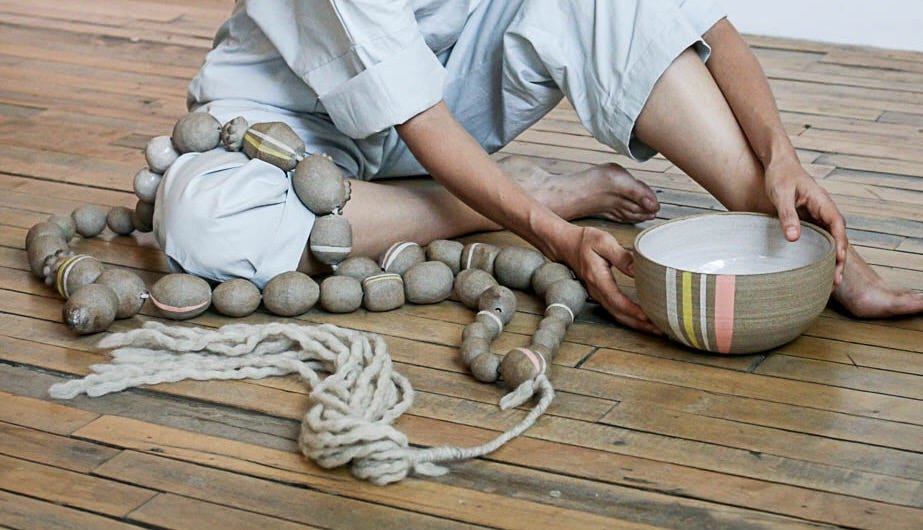
While she generally sticks to designing and creating pieces that are inspired by her own indigenous heritage, she does occasionally reference other cultures in her work (“the fact is, we all have a very similar core”). Dina’s ceramic pieces embody her cultural influences quite literally — whether it’s a Sufi rosary called a sibha, a traditional Yemeni incense burner called a mabkhar, a bowl inspired by ostrich eggs or colors of the Sahara — and she’s unafraid to put this context out there when presenting her creations.
“Some of the most popular Instagram posts that I’ve had lately have been of things that kind of challenge the Western mind,” she remarks. “I recently posted a vintage picture of a ceramic artist in the Congo from the 70s or 80s. Seeing a Congolese man in a fine arts institute in the Congo, making not Western pottery but contemporary African masks, kind of created a glitch in people’s systems. Challenging perceptions is really important for me.”
Nur Ceramics: An idea taking shape
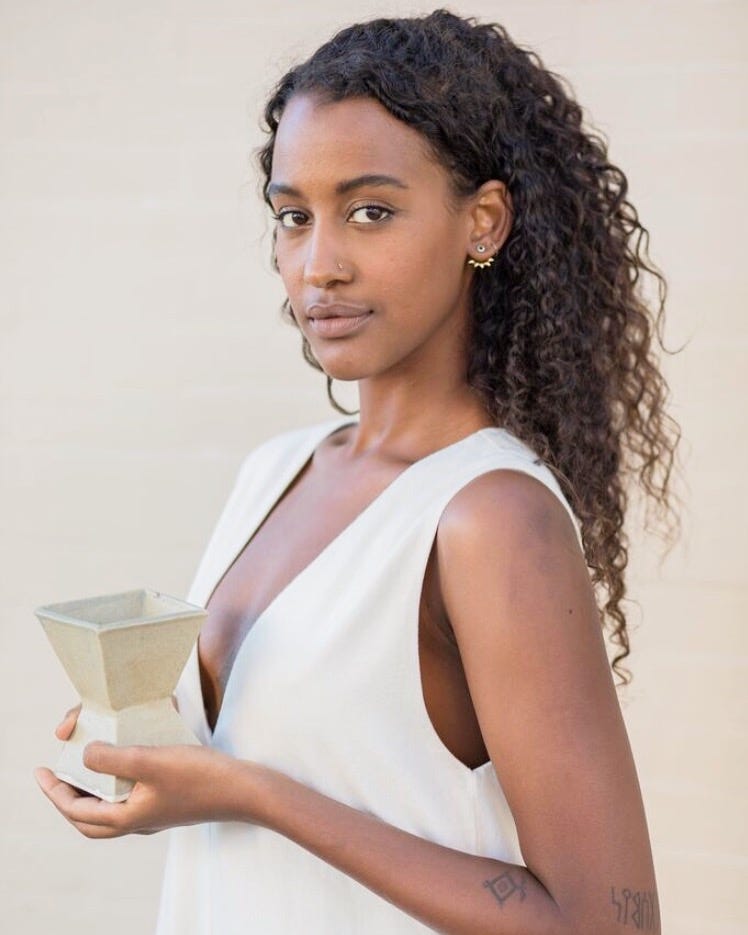
The inception of Nur Ceramics came about somewhat suddenly, about seven years into Dina’s career in development at NYC-based nonprofit The Robin Hood Foundation. After spending the entirety of her twenties working there and being part of a social impact-focused community, she developed an itch for self-exploration. “I started to realize that there was something I was missing in my life. I never had a vehicle that was my own to express ideas that I had on a daily basis, and to share a bigger vision with the world. So I was calling in that thing that would be really special for me. And I knew that there were so many different mediums of art that I felt connected to.”
Dina began by tapping into people she admired all around her. While working at the foundation, she took advantage of spare moments to immerse herself in the art world both in New York and California. Motivated by other female artists and colleagues, she developed passions beyond her day job.
“Women have been a theme throughout my life in terms of having a community of support. [At The Robin Hood Foundation], I had an amazing team of 13 women who always knew I was a little unconventional for the 9-to-5. Outside of that I started to meet other women that were artists and creators,” she explains. “And in a span of about ten years, I was introduced to amazing communities of world music and dance, and I started to connect with a different way of thinking. I felt connected to the idea that we can solve problems in our society through art.”
Through these experiences and the relationships that she cultivated, Dina arrived at an invaluable epiphany. What if these seemingly disparate endeavors — making a difference in the world, and exploring her identity through art — could be achieved simultaneously?
“I saw that we’ve kind of lost the place of art as a central place to bring people together. I love looking at ancient societies because sometimes we overlook the richness and the wealth of those cultures and see them as primitive. The value of what they can teach us is not tangible,” she says. “But they had a more developed understanding of the nuanced ways of taking care of community and people and creating purpose in a community. Art was always this vehicle for defining identities and connecting people to each other. I started to see art in that way and saw that my friends who were artists had this intimate relationship with their art. It created purpose in their life and was a spiritual experience. Their art was connected to their wider journey.”
It took some time, though, for Dina to discern which creative medium would speak to her in a way that could set her course. She knew that she wanted to go back to basics, to hone a craft that was hands-on and purely analog — things that contemporary society is beginning to shed, but that were vital to her ancestors’ daily lives.
“My intention was to find a vessel to connect back to my heritage. And as I met artisans who were older and further along, whether it was a woodworker, or a friend that makes amazing Southwestern style textiles on a loom, meeting these people who were about going back to how things used to be made and honoring long lineages and traditions… these ideas started to come together more clearly.”
A history of colonization was a key theme that surfaced as Dina considered her pursuits as an artist. She knew that her work would represent a hearkening back to her roots and a departure from the hyper-westernization that surrounds us all.
“Both the traditions of my parents come from being colonized multiple times. People think of modern-day European colonization, but we forget about the first wave of Islamic colonization of north and east Africa,” she begins. “I mourn and long for that connection to how my indigenous people might have been. I think of the traditions that I never got to experience, the smells that I never got to smell, the languages that I never got to hear. I wanted to find an art form that connected me back to that.”

Equipped with her academic background and a deep-rooted, layered compulsion to hold her heritage close and ensure it remains in our collective societal psyche, Dina was on the brink of discovering what medium would give her the right tools to embark on this exploration.
“I’d never really thought of ceramics as a path for me — even to this day, I can’t exactly pinpoint the moment that it came into my life. I just kind of woke up one morning in my apartment in Williamsburg, and I had this thought about ceramics. It was with me for a few months and eventually I decided to follow it and see where it would go, so I enrolled in a three month introduction course. It was one of those magical moments where something really clicked.”
While listening to Dina explain this journey, I wrack my brain to try understand how she could have picked up a craft as complex and skill-intensive as pottery so seamlessly. Dina practically reads my mind, explaining that the answer might live within her genetic code. “There’s this thing called cultural memory that I talk about a lot. A group of scientists found that traumas from your ancestors can live on in your body,” she says. “Just last week I had a moment where I was making ceramics and I had this moment of clarity that felt like ‘wow, this is not the first time that my genetics are doing this.’ It’s a really incredible feeling. It’s a way for me to be able to connect with a culture that I never can physically connect to. I’m learning about my own heritage through this practice.”
The name for Nur Ceramics stemmed from her father’s Sudanese tradition and the Islamic practice of passing paternal first names down over generations. Dina’s middle name, Nureldin, means “light of the religion.” “You take on your father’s name as your middle name and it’s a way to trace your lineage. I always loved the name Nur because my paternal grandmother’s maiden name was Abdul-Nur, which means ‘servant of the light’ — a very Jedi name,” she laughs.
She continues, explaining the Sufi concept of Nur: the idea that through your shadows you find light. “It’s this lifelong mystical dedication to allowing and accepting the shadow, because through that you find growth. It’s something that in Western society you don’t really talk about. That there are ways, with support and community, to move through difficulties to better know yourself,” she pauses momentarily. “People are afraid to take leaps of faith to find higher purpose. Nur represents my own personal journey through that, and the dedication of my company as representative of that journey.”
Intentionality in creation

From the outset, Dina never viewed ceramics as *just *ceramics. The concept of creating space and surroundings with intention and purpose has long been a part of her life, and she wanted to ensure that the pieces she creates not only carry cultural significance, but that they also make people feel good and function within the context of a home.
“I grew up with women who felt that if you take care of your home in a physical and spiritual sense, then the outside is taken care of. So creating space was something that I intuitively was good at. I started to see that ceramics could be something that created pause for people on a daily basis,” she elaborates. “They could have a piece in their home that’s a reminder to take a step back. To take a moment to burn some incense in the morning before getting their day started. Or to drink tea or coffee out of a particular cup. Creating a small ritual in their life that connects them to themselves.”
The idea that personal routines influence how we move through and interact with the world continues to come up in our conversation, particularly when it relates to harnessing the power of femininity. “When we have conversations about empowering women we forget to also empower them to be strong in their softness. I love using the representation of ritual in culture as a way to highlight that aspect of womanhood,” she says.
Dina’s work, layered in meaning and historical depth, clearly embodies more than meets the eye. Each piece is nuanced in context and function in addition to shape, color, and texture. But she’s comfortable knowing that people may gravitate toward a product solely based on their aesthetic reaction to it.
“You can drive yourself crazy because you’re like ‘no, this mug is supposed to represent this!’” she laughs. “I read somewhere that art is what the viewer wants to take away from it. And you have to be okay with different surfaces and depths. Someone might look at a mug and just be like wow, there’s something about it I feel drawn to — it’s intangible but I like it.”
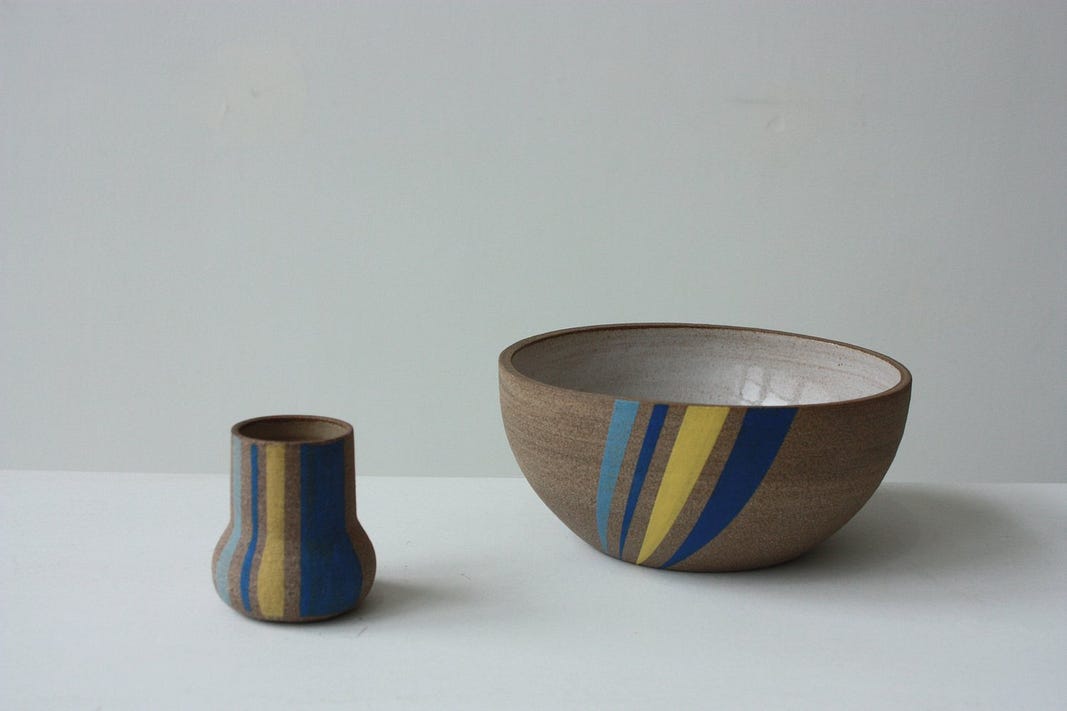
As we discussed the differing perceptions of her work, how some people “get it” on a deep level and others simply jive with the colors and design and vibe, I was curious to hear more about who Dina envisions as her typical customer. While the themes Dina addresses are practically universal, there are certain mindsets that Nur Ceramics particularly resonates with: “people who are on that quest of trying to find meaning and purpose and identity in this time.” Namely, first-generation women in America.
“These are people who can react like, oh, I grew up with these smells, I recognize that ritual, an element of this or that,” she says. She has found that her work also appeals to people in the wellness industry, explaining, “When you’re doing meditation or yoga or are on a spiritual quest, you’re asking questions around purpose and identity and finding moments of peace and connection with yourself.”
For Dina it’s also been important to stay grounded and avoid getting swept away by the glamour of the design world. She strives to ensure that her work continues to be accessible, emphasizing “I don’t want my ceramics to be reserved for a certain type of person or economic tier.”
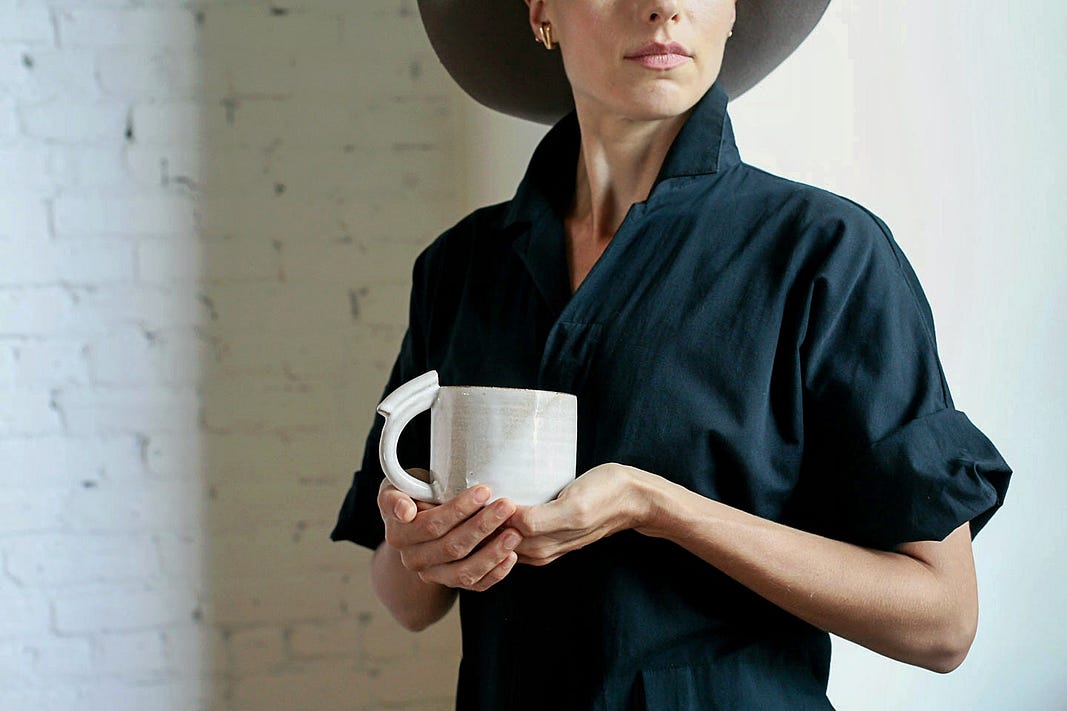
Dina’s philosophy about art existing both for individual self-exploration and a larger, collective experience extends to her sourcing and production methods. She makes an effort to prioritize sustainability and emphasize the value in buying unique, locally made products. “When you buy things that are handmade, you treat them in a different way. You’re not as likely to just dispose of them,” she states. “We’re going through a time in our society where we’re thinking more about how we use things. What is resource responsibility? What are these things that are becoming problems in the bigger climate change story?”
As important as sustainable practices is ethical production, she underscores. “When you start to realize that the experience of the person that’s making your piece matters as much as the piece itself — once you start having conversations on that level, it changes the conversation.”
These ideas have converged into Dina’s long-term vision for Nur Ceramics. “It’s a journey that’s as much on the outside as it is on the inside,” she emphasizes.
A home for collaboration: Nur Ceramics x 10 Rutgers
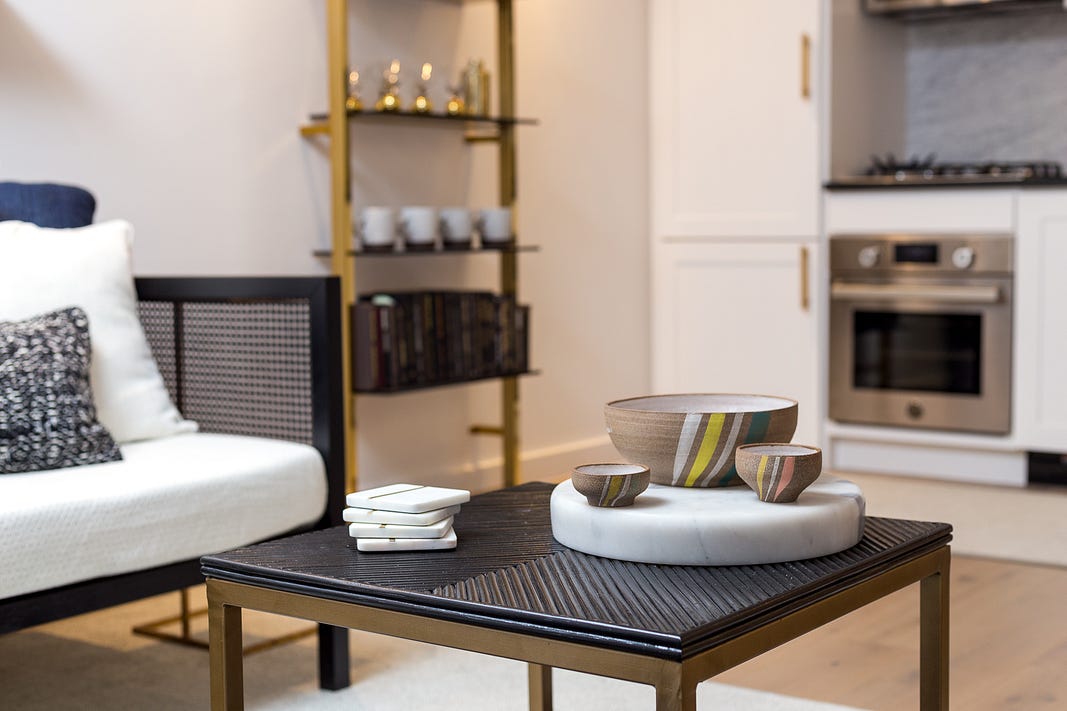
Working with Nooklyn Showroom Director Jordan Ringdahl on a model apartment at 10 Rutgers was an organic and seamless process for Dina; her innate desire to shape spaces compelled her to get involved. “I loved the connection with Nooklyn because it is really about finding home, finding your center in this city. People think of home as just a physical experience but it is very emotional,” she says. “I particularly like the fact that [Nooklyn] has a focus on creating a safe space for women to look for homes. And talking about community-building, they represent a lot of artists. People who are kind of old school in Williamsburg/East Williamsburg/Bushwick love Nooklyn. I love the ethos.”
When they first met, Jordan had already scoped out her work and had his eye on the Sahrawi collection, inspired by its colors referencing Morocco and the Sahara desert. They ultimately settled on a stunning set of bowls that complement both the style of the room and the work of textile silkscreen artist Darragh Rose, who was commissioned to create original wall art for the apartment. The use of color throughout the apartment is clearly thoughtful, balancing simplicity and minimalism with character and depth.
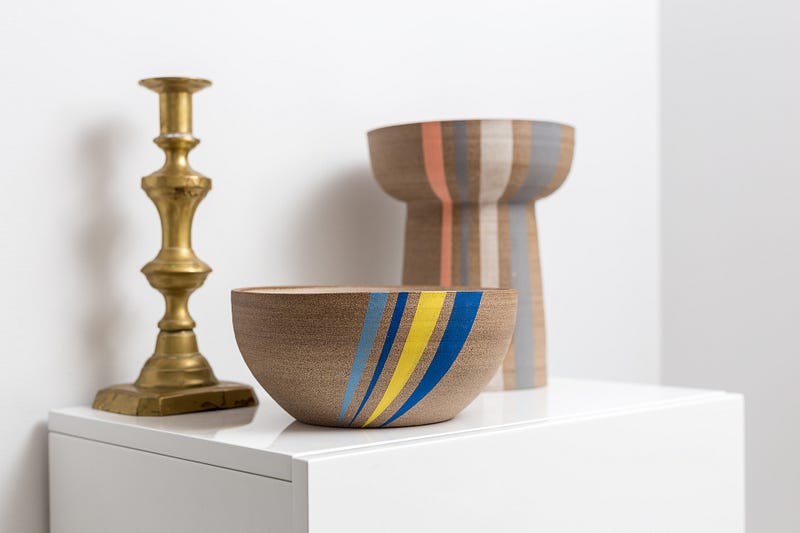
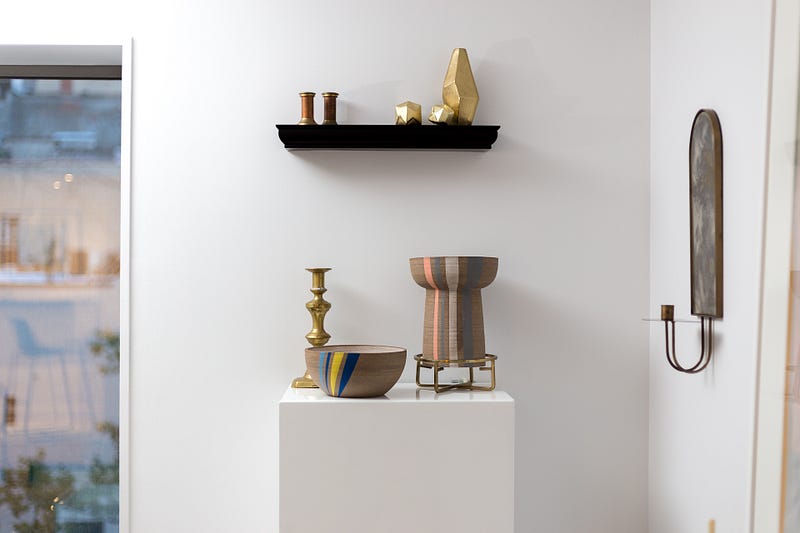
Complementary furniture was curated in partnership with CB2 and Crate and
Barrel. Annie Scott, Regional Business Sales Manager for the company, explains: “Jordan presented the artwork that would be used at 10 Rutgers and we loved that art would be a main anchor of the overall design. We love that Nooklyn’s styling is modern but remains in line with the building’s surroundings and history. CB2 has an urban modern aesthetic but the line also includes a lot of uniqueness which works with the eclectic-ness of the LES neighborhood and charm of the building.”
Thinking back on her experience working with Jordan as the model apartment came together, Dina exclaims: “I love to collaborate in this way — completely trusting in the larger vision, and Jordan delivered in such an amazing way!” She continues, “The brilliance of Jordan is that he’s really good at selecting artists for the right project. When he came to me he already knew what would work and why. We discussed which specific pieces within the collection would be best, and it was decided!”
NYC, an incomparable stomping ground for the arts
Being based in New York City has admittedly come with challenges, but Dina feels strongly that the city has been an important factor in Nur Ceramics’ development. The confines of the traditional New York art world have given way to a burgeoning movement of artists, many from marginalized backgrounds, who want to go their own way. This presents new opportunities to build community and spark partnerships.
“I’ve been talking to fellow women of color in different parts of the art industry. We’re having a bigger conversation about why it’s so difficult to find a place in this Western canon of art as someone who’s pulling from African references,” she says. “You’re always a percentage of the big picture, and there’s always a designated amount for your particular aesthetic. One of the beautiful things that I’m seeing is that people are talking about these patterns and wanting to kickstart a movement for people to create their own spaces.”
As a hub for this movement, NYC has brought new experiences, friends, and collaborators to Dina’s life and work. The acceptance and celebration of culture that she’s found in the city has been vital to her growth as an artist and community member. “New York is a place where, if you’re from an unusual background, you’re not going to feel out of place. It’s a safe space. And New York has the diversity to be able to communicate to Europe and Africa particularly, which are my other home bases.”
On most nights you can find Dina plugging away in her studio at Sculpture Space LIC, whether she’s thinking about branding or experimenting with new ceramic styles. She’s a one woman show, managing all aspects of her business on her own. But on occasional nights off, you might catch her attending an underground boxing fight featuring live rap performances, an inclusive art event, or a topical lecture.
What’s next for Nur?
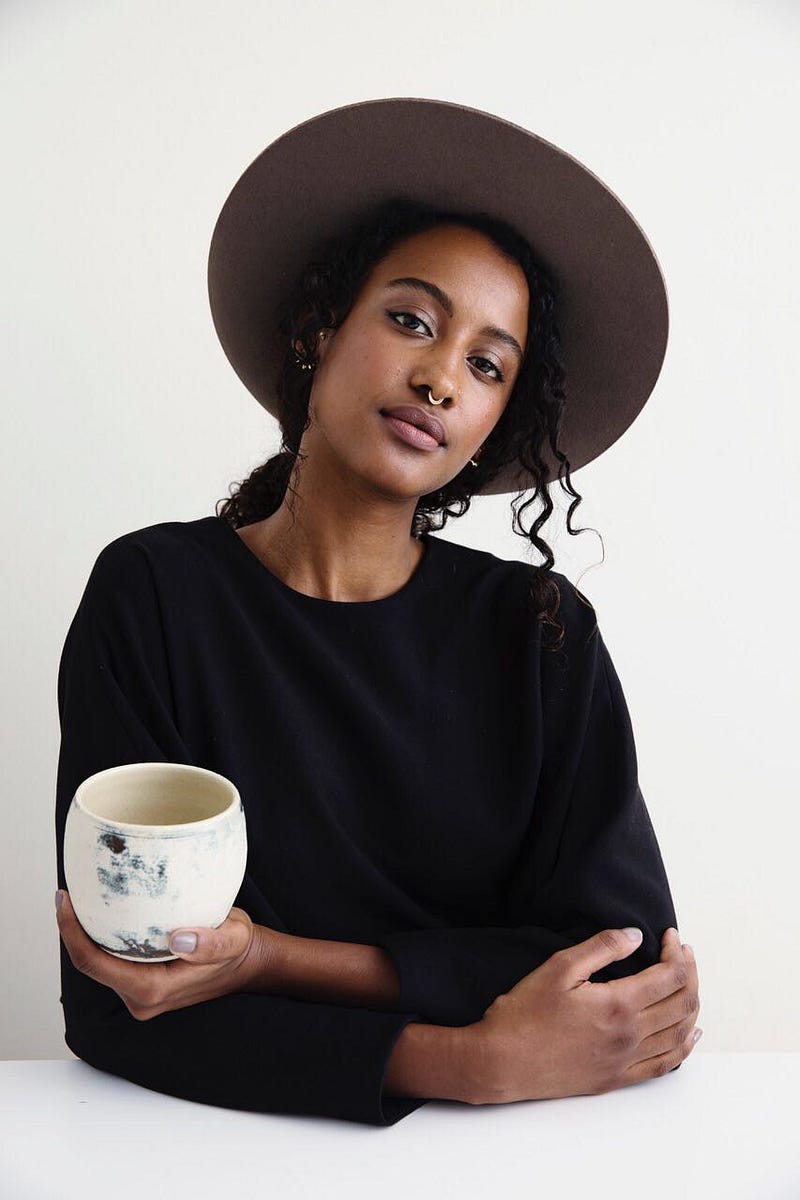
In an effort to keep products accessible, Nur Ceramics is developing a direct-to-consumer online shop that will offer lower prices in the absence of wholesale middlemen. This is part of Dina’s effort to ensure her work gets into the hands of everyday people across income levels and walks of life.
She’s also partnering up with Haremesque, a Brooklyn-based hand-pulled candle line founded by Azza Gallab that is inspired by Sudanese culture and fragrances. Dina and Azza plan to release a collaborative ceramic and candle line, Nur x Haremesque, for the fall and winter.
“The line is especially for people who are trying to decorate a space and want a two-part function. Azza spends time thinking about the elements that make a candle really strong. There’s this thing called ‘throw,’ which is how far the scent travels from the candle. Her candles are known to fill a whole apartment and make it smell really beautiful. We’re inspired to create sculptural ceramic pieces that can also be functional in that way.”
It doesn’t stop there — Dina and Azza have some event ideas up their sleeves as well. Azza’s background is in experience design, having previously worked for Janelle Monae’s Wondaland Records. “We both have that concept of creating space in our story, and we’re connected to a community of world musicians — Indian, Arabic, Persian, West African. So we’re creating some intimate music sessions,” Dina explains of the shared vision. “They’ll have an emphasis on decor, with ceramics and plants and floor seating.”
Dina’s upcoming community-building initiatives include a collaboration with an app creator (“she’s my cousin — well, we’re African, so I call her my cousin but she’s not really my cousin”) who has created a platform called Ditto. The app will be a marketplace for users to buy products made by people from Africa and its diaspora. This is yet another manifestation of Dina’s ambition to shift societal perceptions about the role of African art in contemporary society.
“Africa is trending right now in music and in fashion. Afropunk is a huge movement. All of this is hot right now,” Dina explains. “But how do you create community and space for people to share their work and be supported by people who feel connected to that work? I feel a wider movement happening around that.”
View Nur Ceramics’ latest collections [here (http://www.nurceramics.com/) and find @nur_ceramics on Instagram. Interested in getting a closer look at 10 Rutgers? Follow @10rutgers on Instagram and schedule a tour here.
Photo Credits:
1) Cover photo by Photo by Malin Fezehai
2) Photo by Elena Gorelik
3) Photo by Alexander Kusak
4) Photo by Dina Nur Satti
5) Photo by Malin Fezehai
6) Photo by Dina Nur Satti
7) Photo by Elena Gorelik
8-10) Photos by Nick Doyle
11) Photo by Malin Fezehai